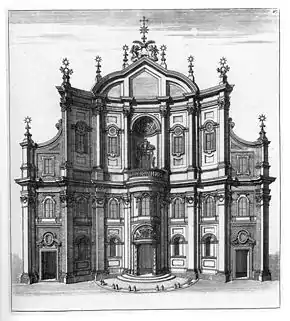| Vallicelliana Library | |
|---|---|
| Biblioteca Vallicelliana | |
 Domenico Barrière, Façade of the Oratorio dei Filippini, 1658 for Roma ricercata nel suo sito | |
| 41°53′54″N 12°28′11″E / 41.89829219483768°N 12.469766463470876°E | |
| Location | Rome, Italy |
| Established | 1569 |
The Biblioteca Vallicelliana is a library in Rome, Italy. The library is located in the Oratorio dei Filippini complex[1] built by Francesco Borromini in Piazza della Chiesa Nuova.[2][3][4]
The library holds about 130,000 volumes of manuscripts, incunabula, and books.[4][5] Among these, there are about 3,000 manuscripts written in Latin and Greek,[4] including a Bible which belonged to Alcuin dating to the 9th century[2] and a lectionary from the 12th century.[6] The library holds documents from the time of the Reformation and Counter-Reformation.
History
The library was established in 1565 by St Filippo Neri who left his collection to the congregation past his death in 1595.[4][2][6][7] Pope Gregory XIII officially recognized the library in 1575 with the bull "Copiosus in misericordia".[2][6][7] The library was mentioned in 1581 when Achille Stazio donated 1,700 printed volumes and 300 manuscripts to Filippo Neri and the Congregation of the Oratory.[4][7] The Archive and part of the Library of San Giovanni n Venere was donated in 1585.[7] In 1604, there were more donations to the library in the form o f books of Pierre Morin and Giovenale Ancina.[7] In 1607, Cardinal Cesare Baronio died and left a part of his library to the Vallicelliana.[6][7] The first library was partially destroyed by a fire in 1620. The current building was built in the subsequent years.[7] In 1644, the Borromini Hall was inaugurated by Francesco Borromini.[2] Borromini directed the construction from 1637 to 1652, and was continued by Camillo Arcucci in 1649 and finished in 1667.[7] In 1669 Leone Allacci[7] presented to the library 243 volumes, 137 Latin and 106 Greek (Fondo Allacci), in 1764 Giuseppe Bianchini presented 293 volumes (Fondo Bianchini), in 1843 Ruggero Falzacappa presented 79 volumes of documents from 17-19th centuries (Fondo Falzacappa).
Manuscripts
In the library are housed the biblical manuscripts: Minuscule 169, 170, 171, 393, 394, 397. The library covers multiple topics, including history, philology, archeology, theology, and more.[4]
References
- ↑ Lowinsky, Edward E (1950). "A Newly Discovered Sixteenth Century Motet Manuscript at the Biblioteca Vallicelliana in Rome". Journal of the American Musicological Society. 3 (3): 173–232. doi:10.2307/829733. JSTOR 829733. Retrieved October 11, 2022.
- 1 2 3 4 5 "Vallicellian Library". Roma Sito Turistico Ufficiale. Archived from the original on October 18, 2021. Retrieved October 10, 2022.
- ↑ "Biblioteca Vallicelliana". Woodbury University. January 24, 2012. Archived from the original on October 12, 2022. Retrieved October 12, 2022.
- 1 2 3 4 5 6 "Un viaggio nella Biblioteca Vallicelliana di Borromini". The Parallel Vision (in Italian). April 28, 2022. Archived from the original on April 28, 2022. Retrieved October 12, 2022.
- ↑ "BIBLIOTECA VALLICELLIANA". American Academy in Rome. Archived from the original on October 11, 2022. Retrieved October 10, 2022.
- 1 2 3 4 "Biblioteca Vallicelliana". Rome Art Week. October 22, 2018. Archived from the original on October 12, 2022. Retrieved October 11, 2022.
- 1 2 3 4 5 6 7 8 9 Scavone, Martina (December 28, 2019). "Biblioteche storiche di Roma: la Biblioteca Vallicelliana". La Citta' Immaginaria (in Italian). Retrieved October 12, 2022.
External links
- Biblioteca Vallicelliana Archived 2009-03-28 at the Wayback Machine at the Ministero per i Beni e le Attività Culturali
- The Biblioteca Vallicelliana - Regole Per La Lingua Maltese
- De Leonis Allati Codicibus qui Romae in Biblioteca Vallicelliana asservantur
- List of press marks, Roma, Biblioteca Vallicelliana